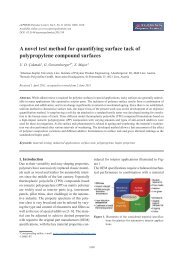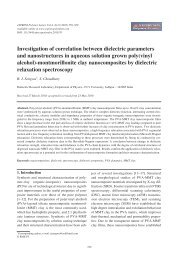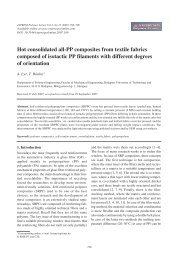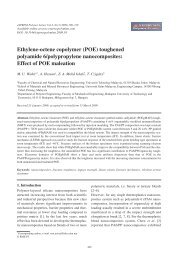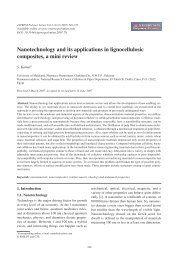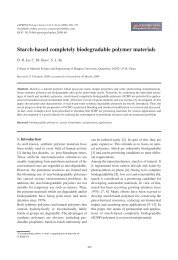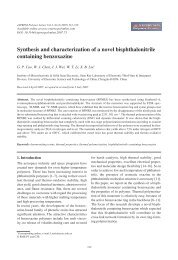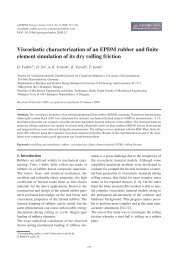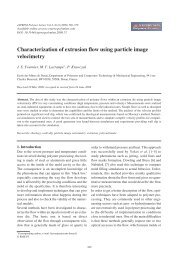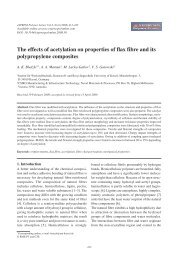Improvement in electrical, thermal and mechanical properties of ...
Improvement in electrical, thermal and mechanical properties of ...
Improvement in electrical, thermal and mechanical properties of ...
You also want an ePaper? Increase the reach of your titles
YUMPU automatically turns print PDFs into web optimized ePapers that Google loves.
Zhou et al. – eXPRESS Polymer Letters Vol.2, No.1 (2008) 40–48Figure 5. DMA results <strong>of</strong> neat <strong>and</strong> nanophased epoxyFigure 6. Normalized weight vs. temperature curves <strong>of</strong>neat <strong>and</strong> nanophased epoxytangular bars measur<strong>in</strong>g 2 mm × 30 mm × 12 mmby a diamond saw.The loss factor curve, tanδ, <strong>of</strong> the neat epoxy <strong>and</strong>its nanocomposites measured by DMA are shown<strong>in</strong> Figure 5. The peak height <strong>of</strong> loss factor decreasedwith higher CNT content, but the temperaturedeterm<strong>in</strong>ed from the peak position <strong>of</strong> tanδ, T g ,<strong>in</strong>creased 17°C. In addition, the width tanδ <strong>in</strong>creasedwith higher CNT content. Similar results have beenobserved <strong>in</strong> other nanocomposites [21]. Figure 5also shows the DMA plots <strong>of</strong> storage modulus vs.temperature as a function <strong>of</strong> load<strong>in</strong>g carbon nanotubes.The storage modulus steadily <strong>in</strong>creasedwith higher CNT weight percents. The addition <strong>of</strong>0.4 wt% <strong>of</strong> carbon nanotube yielded a 93% <strong>in</strong>crease<strong>of</strong> the storage modulus at 30°C. The high aspectratio <strong>and</strong> elastic modulus <strong>of</strong> CNTs, as compared tonanoclay <strong>and</strong> nanoparticles [7, 8], <strong>in</strong>crease the storagemodulus with smaller amounts <strong>of</strong> CNTs.Thermogravimetric Analysis (TGA) was conductedwith a TA Instruments TGA2950 <strong>in</strong> nitrogen gas ata heat rate <strong>of</strong> 10°C/m<strong>in</strong>, from ambient to 600°C.The TGA samples were cut <strong>in</strong>to small pieces us<strong>in</strong>gan ISOMET Cutter <strong>and</strong> were mach<strong>in</strong>ed us<strong>in</strong>g a<strong>mechanical</strong> gr<strong>in</strong>der to ma<strong>in</strong>ta<strong>in</strong> sample weightsbetween 5–20 mg. Universal Analysis 2000-TAInstruments Inc., a data acquisition system, generatedthe real-time characteristic curves. All TGAtests are run <strong>in</strong> nitrogen gas. Figure 6 shows theTGA results <strong>of</strong> neat <strong>and</strong> nanophased epoxy. Thenormalized weights vs. temperature curves <strong>of</strong> fivematerials overlap. All samples started to decomposearound 340°C <strong>and</strong> completely decomposedaround 460°C. The derivative peaks <strong>of</strong> weight vs.temperature curves show the decomposition temperature.But CNT has little effect on decompositiontemperature <strong>of</strong> epoxy.3.3. Mechanical responseFlexural tests were performed accord<strong>in</strong>g to ASTMD790-86 under a three-po<strong>in</strong>t bend configuration.The tests were conducted <strong>in</strong> a 10 kN servo-hydraulictest<strong>in</strong>g mach<strong>in</strong>e equipped with a Test Ware dataacquisition system. The mach<strong>in</strong>e was run under displacementcontrol mode at a crosshead speed <strong>of</strong>2.0 mm/m<strong>in</strong>. All the tests were performed at roomtemperature. Test samples were cut from the panelsus<strong>in</strong>g a Felker saw fitted with a diamond coatedsteel blade. Five replicate specimens from four differentmaterials were prepared for static flexuretests.Typical stress-stra<strong>in</strong> behavior from the flexuraltests is shown <strong>in</strong> Figure 7. All specimens failedimmediately after the tensile stress reached themaximum value. The stress-stra<strong>in</strong> curves showedconsiderable non-l<strong>in</strong>earity before reach<strong>in</strong>g themaximum stress, but no obvious yield po<strong>in</strong>t wasfound <strong>in</strong> the curves. Five specimens were tested foreach condition; the average <strong>properties</strong> obta<strong>in</strong>edfrom these tests are listed <strong>in</strong> Table 1.Table 1. Mechanical <strong>properties</strong> <strong>of</strong> neat <strong>and</strong> nanophasedepoxyModulus[GPa]Strength[MPa]Failure stra<strong>in</strong>[%]Neat epoxy 2.46 093.5 4.020.1% CNT 2.54 109.0 6.060.2% CNT 2.60 115.0 6.800.3% CNT 2.65 121.0 7.580.4% CNT 2.75 113.0 5.1244




